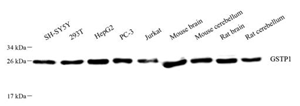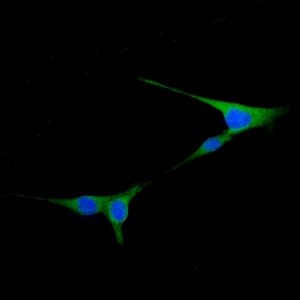Anti-GST3 / GST pi Rabbit pAb (100 μl)
| Reactivity: | H,M,R & M |
| Applications: | WB & ICC/IF |
| Host Species: | Rabbit |
| Clonality: | Polyclonal |
| Gene Name: | Glutathione S-transferase P 1 |
Synonyms: | Gst P1, GST YF-YF, GST class-pi, GST-piB, Preadipocyte growth factor, Gstpib, Gstp1, DFN7, FAEES3, Deafness, Deafness X-linked 7, PI, GST3 / GST pi |
Immunogen: | KLH conjugated Synthetic peptide corresponding to Mouse GST3 / GST pi |
Uniprot ID: | P19157 |
Isotype: | IgG |
Purity: | Affinity purification |
Predicted MW. / Observed MW. | 24 kDa / 24 kDa |
Product Usage Information
WB | Human, Mouse, Rat | 1: 1000-1: 1500 | brain, cerebellum |
ICC/IF | Mouse | 1: 50-1: 200 | NIH-3T3 |
Background
This GST family member is a polymorphic gene encoding active, functionally different GSTP1 variant proteins that are thought to function in xenobiotic metabolism and play a role in susceptibility to cancer, and other diseases. Glutathione S-transferases (GSTs) are a family of enzymes that play an important role in detoxification by catalyzing the conjugation of many hydrophobic and electrophilic compounds with reduced glutathione. Based on their biochemical, immunologic, and structural properties, the soluble GSTs are categorized into 4 main classes: alpha, mu, pi, and theta.
Images
| Western blot analysis of GSTP1 (GB111885) at dilution of 1: 1000 |
| Immunocytochemistry analysis of 4% paraformaldehyde-fixed NIH-3T3 cells using GST3(GB111885) at dilution of 1: 50-1: 200 |
Storage
| Storage | Store at -20°C for one year. Avoid repeated freeze/thaw cycles. |
| Storage Buffer | PBS with 0.02%sodium azide,100 μg/ml BSA and 50% glycerol. |


